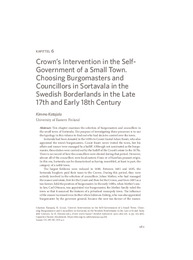Crown’s Intervention in the Self-Government of a Small Town. Choosing Burgomasters and Councillors in Sortavala in the Swedish Borderlands in the Late 17th and Early 18th Century

Files
Self archived version
published versionDate
2022Author(s)
Metadata
Show full item recordSelf-archived item
Citation
Katajala, Kimmo. (2022). Crown’s Intervention in the Self-Government of a Small Town. Choosing Burgomasters and Councillors in Sortavala in the Swedish Borderlands in the Late 17th and Early 18th Century. Cappelen Damm, 161-186.Rights
Abstract
Abstract: This chapter examines the selection of burgomasters and councillors in the small town of Sortavala. The purpose of investigating these processes is to use the typology in this volume to find out who had decisive control over the town.
Sortavala had been donated in the 1650s to Count Gustaf Adam Banér, who also appointed the town’s burgomasters. Count Banér never visited the town, but his affairs and manor were managed by a bailiff. Although not nominated as the burgomaster, these duties were carried out by the bailiff of the Count’s estate in the 1670s.There is no record of how the councillors were elected during that period. However, almost all of the councillors were local eastern Finns or of Karelian peasant origin. In this era, Sortavala can be characterised as having resembled, at least in part, the category of a noble town.
The largest fiefdoms were reduced in 1680. Between 1681 and 1685, the Sortavala burghers paid their taxes to the Crown. During this period, they were actively involved in the selection of councillors. Johan Mether, who had managed the manor and estate, first for the Count and then for the Crown, and from 1685 as a tax-farmer, held the position of burgomaster. In the early 1690s, when Mether’s son-in-law, Carl Ottoson, was appointed vice burgomaster, the Mether family ruled the town so that it assumed the features of a privatised monopoly town. The influence of the manor increased even further when Salomon Enberg, who was also appointed burgomaster by the governor general, became the new tax-farmer of the manor.
Under Enberg, the role of the town’s burghers in the election of the burgomaster and the councillors seems to have completely vanished. After Enberg, the governor general appointed Benjamin Krook as burgomaster. There is no information on how new councillors were selected during his time. However, the names and backgrounds of the new councillors suggest that education or social status was now an important selection criterion. Under Benjamin Krook, the link between the manor and the burgomaster’s post seems to have been broken, so that in the last decade before being destroyed in the war in 1710, Sortavala ranks quite clearly in the state-led town category in urban typology.


